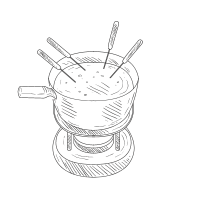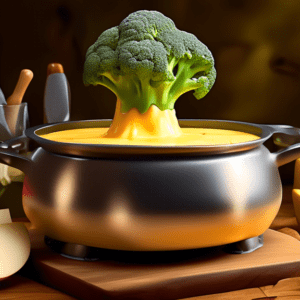How to Make Fondue in a Fondue Pot: A Step-by-Step Guide
Fondue, the Swiss culinary delight, evokes images of cozy gatherings and shared culinary experiences. More than just a meal, fondue is an interactive and fun way to enjoy delicious food with friends and family. While the concept might seem intimidating, mastering the art of making fondue in a fondue pot is surprisingly simple. This comprehensive guide will equip you with all the knowledge you need to become a veritable fondue aficionado, from choosing the right cheese to mastering the perfect dipping technique.
What is Fondue?
Fondue, at its heart, is a communal dish where bite-sized pieces of food are dipped into a shared pot of simmering liquid or sauce kept warm over a small burner. Originating in Switzerland, the word fondue comes from the French verb fondre, meaning to melt, perfectly encapsulating the essence of this dish.
Types of Fondue
While cheese fondue reigns supreme, the world of fondue extends far beyond melted cheese. Here are some popular variations:
- Cheese Fondue: The classic Swiss fondue, typically made with a blend of Gruyère and Emmental cheeses melted with white wine and seasoned with garlic and Kirsch.
- Chocolate Fondue: A decadent dessert fondue where pieces of fruit, cake, or marshmallows are dipped into a luxuriously smooth melted chocolate mixture.
- Meat Fondue: Also known as fondue bourguignonne, this savory fondue involves cooking small pieces of meat in hot oil or broth directly at the table.
Choosing the Right Fondue Pot
The right fondue pot is crucial for a successful fondue experience. Consider these factors when making your selection:
- Material: Fondue pots come in various materials, including stainless steel, ceramic, and cast iron. Stainless steel is durable, easy to clean, and heats evenly. Ceramic pots offer excellent heat retention but can be more fragile. Cast iron heats slowly but retains heat exceptionally well, making it ideal for meat fondue.
- Size: The size of your fondue pot should align with the number of people you intend to serve.
- Heat Source: Most fondue pots use either a gel fuel burner or a small electric heating element. Gel fuel burners provide a traditional ambiance but require monitoring and replacement. Electric fondue pots offer consistent heat and are generally easier to regulate.
Mastering Cheese Fondue: A Step-by-Step Guide
Let’s dive into creating the quintessential cheese fondue experience with this detailed recipe:
Ingredients:
- 1 clove garlic, halved
- 1 cup dry white wine, such as Sauvignon Blanc or Pinot Grigio
- 1 tablespoon cornstarch
- 1/4 teaspoon freshly grated nutmeg
- 1/8 teaspoon black pepper
- 1/4 teaspoon dry mustard
- 1 pound Gruyère cheese, shredded
- 1 pound Emmental cheese, shredded
- 1 tablespoon Kirsch (cherry brandy), optional
- For dipping: crusty bread cubes, steamed vegetables, boiled potatoes
Instructions:
1. Preparing the Fondue Pot:
Begin by rubbing the inside of your fondue pot with the cut side of the garlic clove. This imparts a subtle garlic flavor to the cheese mixture.
2. Creating the Cheese Base:
In a small bowl, whisk together the cornstarch, nutmeg, pepper, and dry mustard. Set aside.
3. Melting the Cheese:
Place the fondue pot over low heat on your stovetop. Pour in the white wine and bring it to a gentle simmer. Gradually add the shredded cheese, a handful at a time, stirring constantly with a wooden spoon or whisk in a figure-eight motion.
As the cheese melts, it will create a smooth and creamy base. Continue adding the cheese slowly, ensuring each addition melts before adding more.
4. Thickening and Flavoring:
Once all the cheese has melted and the fondue is smooth, gradually whisk in the cornstarch mixture. This will help to thicken the fondue and prevent it from separating.
If desired, stir in the Kirsch, which adds a subtle fruity and boozy complexity.
5. Serving and Enjoying:
Transfer the fondue pot to its heating base. Ensure the flame is low to keep the fondue at a gentle simmer.
Arrange your chosen dipping items on a platter and gather around the fondue pot. Each person can spear their chosen morsel with a fondue fork and swirl it in the cheesy goodness.
Beyond the Cheese: Exploring Meat and Chocolate Fondue
While cheese fondue holds a special place in many hearts, meat and chocolate fondues offer enticing alternatives.
Meat Fondue (Fondue Bourguignonne):
For meat fondue, heat neutral-flavored oil (such as canola or peanut oil) in your fondue pot. Diners can then cook bite-sized pieces of tender meat to their liking by spearing them on fondue forks and submerging them in the hot oil. Accompany the cooked meat with an array of dipping sauces, such as béarnaise, horseradish cream, or garlic butter.
Chocolate Fondue:
Indulge your sweet cravings with a luxurious chocolate fondue. Melt high-quality bittersweet or semisweet chocolate with heavy cream over low heat. For added flavor, consider incorporating a splash of liqueur, such as Grand Marnier or Baileys Irish Cream. Dip a variety of treats, such as fresh strawberries, bananas, marshmallows, pound cake, or brownies, into the warm chocolate for a truly decadent dessert experience.
Tips for Fondue Success:
- Shred your own cheese: Pre-shredded cheese often contains cellulose, which can hinder melting and result in a grainy texture. Shredding your own cheese ensures optimal melting and a smooth fondue.
- Don’t overheat the cheese: High heat can cause the cheese to separate and become stringy. Maintain a low and gentle heat throughout the cooking process.
- Use dry white wine: The acidity in dry white wine helps to balance the richness of the cheese. Avoid sweet wines, which can make the fondue overly sweet.
- Keep it moving: Stir the fondue regularly to prevent the cheese from sticking to the bottom of the pot and burning.
- Don’t overcrowd the pot: When dipping, avoid overloading the fondue forks. This can cool down the fondue and make it difficult to maintain a consistent temperature.
- Embrace the lost piece: Tradition dictates that the person who loses their bread or dipping item in the fondue pot must buy the next round of drinks or perform a playful penalty.
Conclusion:
Fondue is more than just a meal; it’s a delightful culinary adventure. Armed with this comprehensive guide, you’re ready to host your own fondue party. Gather your loved ones, prepare your dipping items, and embark on a journey of shared culinary pleasure. From the savory indulgence of cheese fondue to the sweet temptations of chocolate fondue, the possibilities are endless. So fire up your fondue pot and prepare to create unforgettable memories, one delicious dip at a time.

